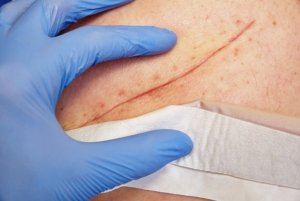Basic Wound Closure Techniques


Written and verified by the doctor Nelton Abdon Ramos Rojas
As a general rule, wounds are injuries that can take place on the outer surface of the body. They can also be defined as a loss of skin continuity due to an external factor. Depending on the characteristics of the wound, the medical team may choose to proceed with its closure or leave it to close naturally on its own.
Currently, one of the most commonly used techniques in wound closure is stitches. However, there are numerous variants within this method and the doctor must choose the most suitable one for the patient’s wound.
First, let’s take a look at how to classify a wound in order to determine how best to treat it.
Wound Classification
After an injury, the body activates in several phases in order to heal.
First, one of the first properties that you should always check is the cleanliness of the wound.
On the one hand, recent injuries are fresh and not contaminated or infected. On the other hand, dirty wounds may be more delayed, they appear to have more torn tissue and be contaminated or have foreign bodies in them.
Another way to classify a wound is based on the agent or cause of the injury (stabbings, fire, etc.).
You can also differentiate them based on their appearance or if the wound affects other structures to part of the skin, among other classifications.
Wound Healing Phases
Normally, wounds follow a regeneration or healing pattern that consists of the following steps:
- Inflammation. Also called the reaction phase, this appears during the first few days. When this happens, the blood vessels dilate and the vascular permeability increases. This way, serous fluid and leukocytes are filtered form a protective layer (scab).
- Proliferation phase. This is also known as the regeneration phase or the granulation phase. It takes place on the third day of injury and finishes 1 to 2 weeks later. In this phase, the body begins to produce the collagen that has been lost and the lymphatic and blood vessels recover.
- Maturation phase. This is sometimes identified as the wound’s “remodeling” phase. It starts a few weeks after injury and finishes several years later. When this happens, the scar decreases in depth and size. Finally, the patient has a paler color in the area where the injury was.
Read this article, too: Advice: How to Heal Wounds of the Past and Eliminate Pain
How to Encourage Healthy Wound Closure
It is always best to go to a doctor in the case of a serious wound.
There, the group of specialists will follow the general procedure to treat wounds. A list of priorities should be followed in case of an accident or emergency.
First of all, the patient may need to undergo anesthesia to reduce the discomfort associated with wound closure. General or local anesthesia can be administered depending on the severity of the injury. To do so, the patient will be injected with one or more drugs such as lidocaine.
Then, the group of specialists will carefully and gently withdraw the foreign bodies that can be found inside the wound, if this is the case. To do so, the most appropriate and sterilized tools will be used.
Afterward, an abundant amount of saline solution should be administered to the area in order to properly clean it.
Check out this article, too: How to Treat Postpartum Hemorrhages
Wound Closure Techniques
If necessary, the doctor may use stitches, tape or staples to unite the tissues that have been detached by the wound. Depending on the properties of the injury, the corresponding medical team will determine which type of stitches would be most appropriate:
- Adhesive tape. This consists of a set of sections of tape that are placed near the extremes of the wound. As a general rule, they naturally peel off within a few days of placement (especially if they get wet).
- Staples. These are small metallic threads that come in the shape of a clip that keep the edges of the wound firm in order to promote healing and tissue regeneration. They must be removed by using a special medical tool.
- Thread stitches. There is a great variety of knots and types of threads that the group of specialists can use depending on the tissue and shape of the wound. A needle is used to sew the entire length of the wound.
Overall, it is very important to go to the doctor as soon as possible in order to get the best treatment for a wound and ensure healthy wound closure.
All cited sources were thoroughly reviewed by our team to ensure their quality, reliability, currency, and validity. The bibliography of this article was considered reliable and of academic or scientific accuracy.
- Gibran, N. S., Boyce, S., & Greenhalgh, D. G. (2007). Cutaneous wound healing. In Journal of Burn Care and Research. https://doi.org/10.1097/BCR.0B013E318093E44C
- Frykberg, R. G., & Banks, J. (2015). Challenges in the Treatment of Chronic Wounds. Advances in Wound Care. https://doi.org/10.1089/wound.2015.0635
- Atiyeh, B. S., Dibo, S. A., & Hayek, S. N. (2009). Wound cleansing, topical antiseptics and wound healing. International Wound Journal. https://doi.org/10.1111/j.1742-481X.2009.00639.x
- Powers, J. G., Higham, C., Broussard, K., & Phillips, T. J. (2016). Wound healing and treating wounds Chronic wound care and management. Journal of the American Academy of Dermatology. https://doi.org/10.1016/j.jaad.2015.08.070
This text is provided for informational purposes only and does not replace consultation with a professional. If in doubt, consult your specialist.










